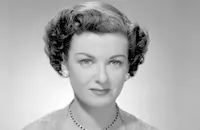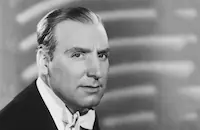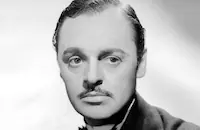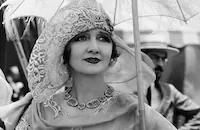Walter Wanger's Vogues of 1938
Brief Synopsis
Cast & Crew
Irving Cummings
Warner Baxter
Joan Bennett
Helen Vinson
Mischa Auer
Alan Mowbray
Film Details
Technical Specs

Synopsis
George Curson is the owner of the fashionable House of Curson on New York's Fifth Avenue. When Mrs. Van Klettering insists that her debutante daughter Wendy marry wealthy Henry Morgan because of the poor financial status of the family, Wendy requests that George not have her wedding dress delivered on time so that she can get out of the wedding. George refuses, and Wendy's subsequent absence at the wedding results in headlines which humiliate Morgan. He then brings a court injunction to prevent Wendy from modeling for the Curson fashion show because, he contends, that would embarrass him in public. Taking the court action as a dare, Wendy, with George as her escort, parades through the show wearing a selection of new fashions, but says that she is only a spectator. In retaliation, Morgan backs George's competitor, Prince Muratov, who tries to ruin the House of Curson by obtaining the Curson client list and buying the new Paris fashions first. George gives in to his wife Mary's wish that he back a show, Brockton's Vogues of 1938 , to give her a chance to perform again, but the show flops in Boston, and George returns to New York alone and in debt. After George refuses to sell his building to Morgan, Wendy proposes to Morgan to save George financially, but Morgan now refuses. George is able to ruin Muratov by copying his creations and having Wendy wear them wherever Muratov's clients go, so that the women will think their clothes are not originals. George still cannot get financing to save his business, so using the costumes, props and lights from Brockton's show, he puts on a fall extravaganza that makes his creditors anxious to loan him money again. Although Morgan tries to close the show, Muratov, who, to pay his debt of honor to George, works as the doorman, locks Morgan in an elevator. At the close of the show, George learns that Mary, to whom he has been faithful despite Wendy's flirtations, has divorced him in Reno to pursue an acting career. He now proposes to Wendy and she accepts.

Director
Irving Cummings
Cast

Warner Baxter

Joan Bennett

Helen Vinson

Mischa Auer

Alan Mowbray

Jerome Cowan
Alma Kruger

Marjorie Gateson

Dorothy Mcnulty
Polly Rowles
Georgie Tapps
Virginia Verrill
Fred Lawrence
Gloria Gilbert
Olympic Trio
Wiere Brothers
Rocco And Saulter
The Four Hot Shots
Victor Young
Peggy Calvin
Betty Wyman
Martha Heveran
Phyllis Gilman
Elizabeth Harben
Ida Vollmar
Dorothy Day
Mary Oakes

Katharine Aldridge
Olive Cowley
Frances Joyce
Noreen Carr
Ruth Martin
Betty Douglas

Hedda Hopper
Maria Shelton

Roman Bohnen
Crew
Louis Alter
Lew Brown
Sammy Fain
Seymour Felix
Winton Hoch
Natalie Kalmus
Charles Kerr
Frank Loesser
Otho Lovering
Boris Morros
Paul Neal
Ray Rennahan
Manning Sherwin
Dorothy Spencer
Bella Spewack
Samuel Spewack
Alexander Toluboff
Walter Wanger
Paul F. Webster
Victor Young

Photo Collections
Videos
Movie Clip



Film Details
Technical Specs

Award Nominations
Best Art Direction
Best Song
Articles
Vogues of 1938
In Vogues of 1938 Bennett plays a fashion-plate debutante who creates havoc for Warner Baxter as the owner of a fashionable design shop on New York's Fifth Avenue after he refuses her request to delay the creation of a wedding dress so she won't have to get married. Baxter's other problems include a nagging wife and a jealous rival who wants to steal his business. But the movie's plot is mainly an excuse for a parade of 1930s fashions in gorgeous Technicolor. Also included are several musical numbers including the Oscar-nominated Les Brown/Sammy Fain "That Old Feeling," which is sung in the movie by Virginia Verrill and has since become a standard.
Vogues of 1938 also was Oscar®-nominated for its art direction, which uses subtle greys and metallic colors in the background to set off the pastel colors of the fashions. Wanger had wanted to make a "Vogues" movie since 1934, when he had signed Frances Langford to star in such a film, but decided to wait for the Technicolor process to become perfected. Wanger was very sensitive to this subject, having produced the first three-color outdoors adventure, The Trail of the Lonesome Pine (1936).
Langford filmed some scenes for Vogues of 1938, according to production schedules of the time, although she does not appear in the completed film. The fashion sequences feature prominent models of the day including those known as the Lucky Strike Girl, the Chesterfield girl, the Lux Soap Girl and the Pepsodent Girl. Hedda Hopper, later to gain notoriety as a gossip columnist, also has a role.
Producer: Walter Wanger
Director: Irving Cummings
Screenplay: Bella Spewack, Sam Spewack
Cinematography: Ray Rennahan
Production Design/Art Direction: Alexander Toluboff
Original Music: Louis Alter, Sammy Fain, Victor Young (all uncredited)
Editing: Otho Lovering, Dorothy Spencer
Costume Design: Helen Taylor (uncredited)
Principal Cast: Warner Baxter (George Curson), Joan Bennett (Wendy Van Klettering), Helen Vinson (Mary Curson), Mischa Auer (Prince Muratov), Alan Mowbray (Henry Morgan).
C-105m.
by Roger Fristoe

Vogues of 1938
Quotes
Trivia
Walter Wanger wanted to make a Vogues movie since 1934 (he signed Frances Langford for it in December 1934), but waited till the Technicolor process reached a higher state of development. Langford was listed as member of the cast till 1937 and it is unknown if there were any scenes with her shot, but she does not appear in the final version.
Notes
At the end of the opening credits, the following statement appears: "We wish to thank the following for their many creative contributions to this production: Jaeckel, Inc. for furs; Irene-for Miss Bennett's Wardrobe; Omar Kiam-for the Fashion Shows and Miss Vinson's Wardrobe; Max Factor-for Color Harmony Make-up; Sally Victor-for a great many of the hats; John-Frederics-for the hats and accessories in the Fall Fashion Forecast; Trabert & Hoeffer Inc. "Mauboussin Jewels" for the jewelry; I. Miller & Sons-for shoes; And the many others whose creative efforts have found expression in this motion picture." According to Hollywood Reporter, Helen Taylor designed the clothes in the opening sequence and the lighting idea for at the Rayon Ball.
This film was reviewed under the title Vogues of 1938. It originally was to be titled Vogues of 1937, but the year in the title was changed due to a late release date, according to a Hollywood Reporter news item. The film had its preview on August 2, 1937 at Grauman's Chinese Theatre in Hollywood. Reviews praised the quality of the color and predicted that the film would make Technicolor a box office asset. According to contemporary sources, Walter Wanger, who produced the first three-color Technicolor outdoors feature, The Trail of the Lonesome Pine planned this film more than two years earlier but waited until Technicolor was perfected before producing it. Contemporary sources note that samples of every cloth and fur were tested for their Technicolor reaction. According to the pressbook, production designer Alexander Toluboff had the idea to treat the background sets in grays and metallic hues to offset the foreground color. Models in the film included the Lucky Strike Girl, the Chesterfield Girl, the Lux Soap Girl and the Pepsodent Girl. Location shooting was done in New York City. Frances Langford is listed as a cast member in Hollywood Reporter production charts, but her participation in the final film is doubtful. Toluboff received an Academy Award nomination for his work on the picture. The song "That Old Feeling" was also nominated.

Miscellaneous Notes
Released in United States 1937
Released in United States 1937













